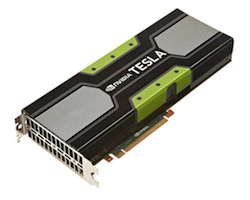The digital ink has barely dried on NVIDIA’s K40 GPU announcement, but the engineering team over at Xcelerit have already gotten their hands on one. Xcelerit, which runs a business optimizing codes for accelerators, is also becoming known as the go-to benchmarking resource for the latest accelerators and multicore chips.
Compared to its previous high-end Kepler, the K20X, the NVIDIA Tesla K40 touts more memory, higher clock rates, and more CUDA cores. But how do these specs pay off in terms of actual performance improvements for real-world financial applications? This is what the Xcelerit team wanted to know, so they arranged a face-off between the K40 and the K20X using the Monte-Carlo LIBOR swaption portfolio pricer as the yardstick.
The hardware comparison breakdown is illustrated with this table:
| Tesla K20X | Tesla K40 | |
| SMX | 14 | 15 |
| CUDA Cores | 2,688 | 2,880 |
| Memory | 6 GB | 12 GB |
| Core Frequency | 732 MHz | 745 MHz |
| Max. Frequency | 784 MHz | 875 MHz |
| Memory Bandwidth | 250 GB/s | 288 GB/s |
Jörg Lotze, technical lead and co-founder at Xcelerit, explains that aside from the obvious differences in clock speeds, core count and memory, the most significant enhancement to the K40 is a GPU Boost mode that turns up the frequency on those CUDA cores. Up to 17 percent higher frequency is possible as long as the device stays within its specified thermal envelope. Exceeding that limit will cause the clock to be automatically throttled. The K20X only allows a small clock boost of 7 precent.
The benchmark employs Monte-Carlo LIBOR swaption portfolio pricing. This is a common financial algorithm used to price a portfolio of LIBOR swaptions. It involves the simulation of thousands of possible future development paths for the LIBOR interest rate. For each of these paths, the value of the swaption portfolio is computed by applying a portfolio payoff function. Both the final portfolio value and an interest rate sensitivity value are obtained by computing the mean of all per-path values.
For a high number of paths, the algorithm becomes compute bound, creating a scenario where the additional cores and higher clock speeds should create a significant performance boost.
The application was implemented with the Xcelerit software on two systems, each outfitted with dual Intel Xeon E5s and the target GPU.
From the blog:
We measured the computation times for the Monte-Carlo LIBOR swaption portfolio pricer on one GPU of each system, pricing a portfolio of 15 swaptions over 80 time steps and using varying numbers of Monte-Carlo paths. The run time of the full algorithm – including random number generation, data transfers, core computation, and reduction – is compared for single and double precision in the graph below. All these computation steps are running on the GPU, so the difference in the used CPUs does not affect the benchmark results.
With the default clock frequency settings, the K40 returned a speedup of between 1.1 and 1.2 times. When the team tested the application with frequency dialed up all the way, the K40 performance boost was even more pronounced, between 1.2 and 1.25 times higher.
The Xcelerit team created this chart with several notable points of comparison:
| Paths | Speedup (def. clock, single) | Speedup (def. clock, double) | Speedup (max. clock, single) | Speedup (max. clock, double) |
| 16K | 1.15x | 1.17x | 1.21x | 1.21x |
| 256K | 1.15x | 1.17x | 1.21x | 1.26x |
| 1024K | 1.15x | 1.18x | 1.22x | 1.28x |
The benchmarking results show that the K40 provides a significant performance improvement for this real-world financial application, up to 1.28x with the higher clock speed enabled. The Xcelerit rep notes that the speedup is pretty constant across number of paths, too, indicating that even small loads benefit from the new GPU. “Together with the doubled memory capacity, this makes a strong case for the Tesla K40 GPU,” he writes.


























































